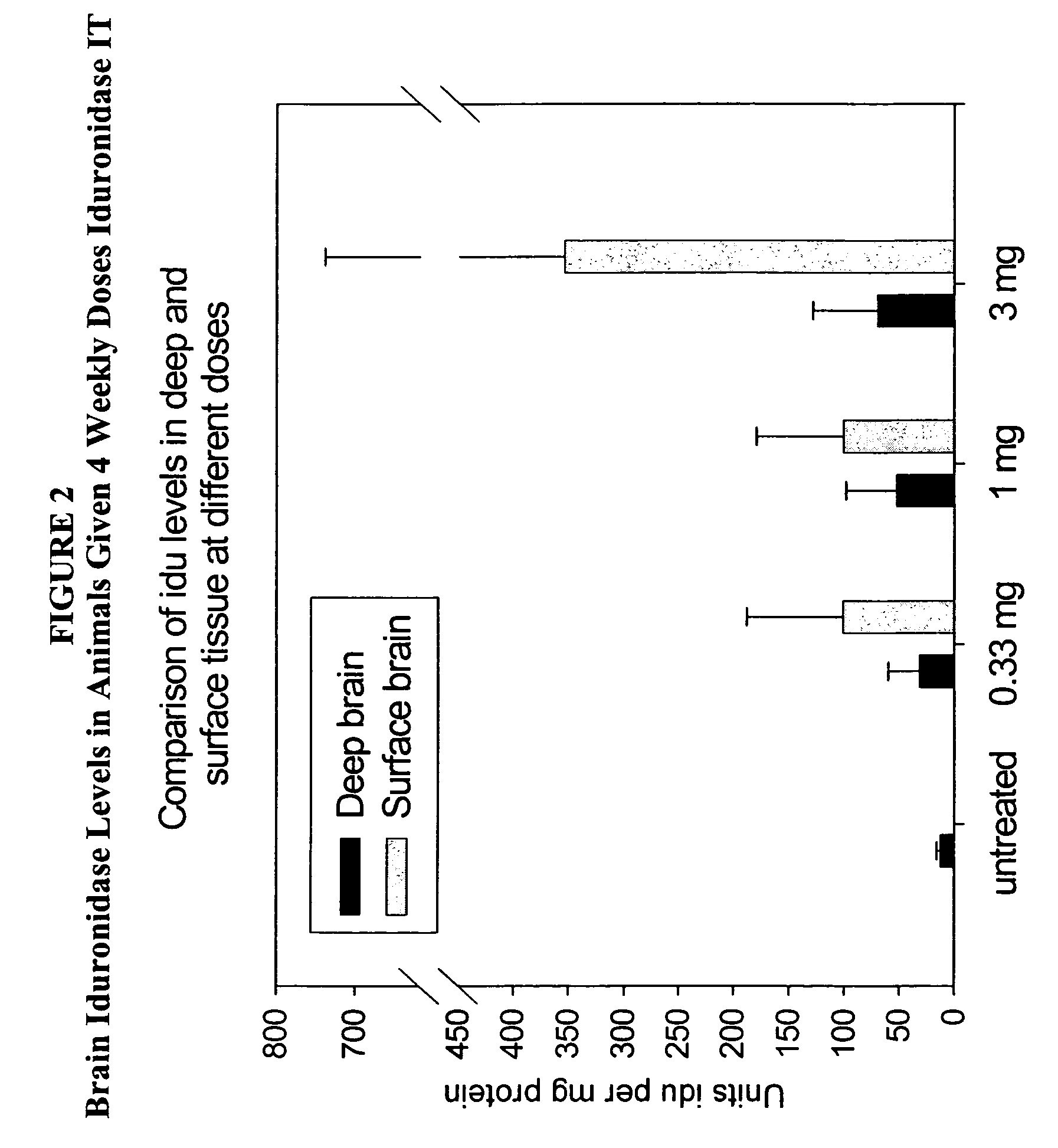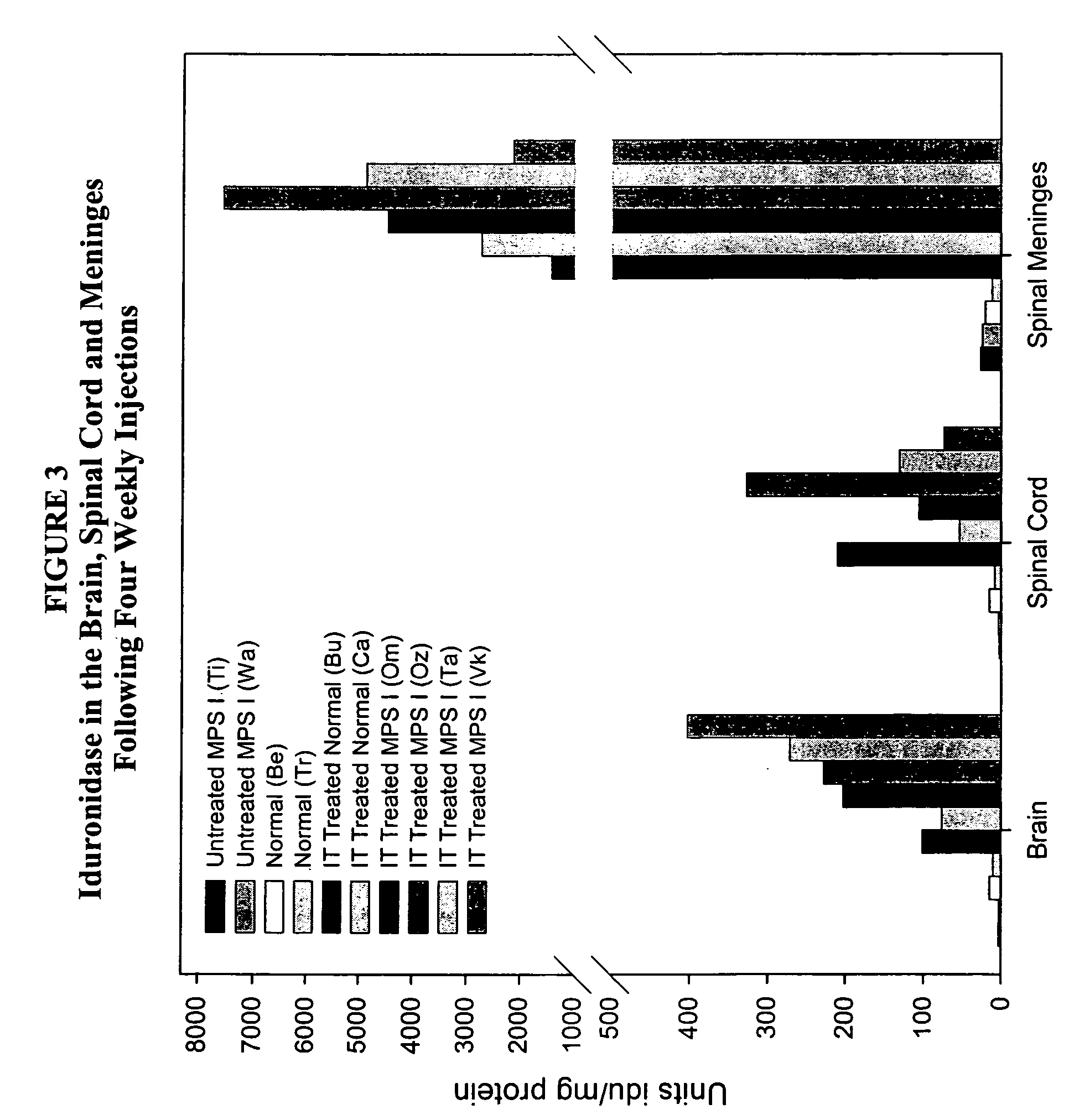Delivery of therapeutic compounds to the brain and other tissues
a technology of therapeutic compounds and brain, applied in the direction of drug compositions, peptide/protein ingredients, metabolic disorders, etc., can solve the problems of significant impedement of the access of beneficial active agents by the blood-brain barrier (bbb), accumulation of undegraded “storage materials, and significant impedement in the management of neurological manifestations of lysosomal storage diseases (lsds). , to achieve the effect of reducing the amount of storage granul
- Summary
- Abstract
- Description
- Claims
- Application Information
AI Technical Summary
Benefits of technology
Problems solved by technology
Method used
Image
Examples
example 1
Protocols for Assessing Direct Injection of the Brain with Recombinant Human Iduronidase
[0101]Those of skill in the art also are aware of well-known canine models for lysosomal storage diseases. In one embodiment, MPS I canines are used to assess the efficacy of the methods of the present invention. For such determinations, it is desirable that normal canines and MPS I canines are assessed concurrently. The following example provides exemplary protocols for use in conjunction with the methods described herein.
[0102]In order to assess enzyme penetration in the brain of normal canines, normal beagle dogs (e.g., 2 initially planned, up to 4 possible) are prepared for anesthesia and sterility. An Ommaya reservoir or equivalent device is implanted with a ventricular catheter placed in the lateral ventricle. A CSF reservoir and lumbar catheter may also be implanted in the lumbar region. CSF is withdrawn to confirm patency. Enzyme administration and CSF sampling is performed at the lateral...
example 2
Enzyme Administered Via Intraventricular Injection Penetrates Blood Brain Barrier and is Detected in Brain Tissue
[0127]Administration of enzymes directly to the site of lysosomal storage induced damage in the brains of subjects with lysosomal storage disorder has proven difficult to this point. The large enzyme complexes necessary to treat these diseases typically cannot penetrate the blood brain barrier. To determine an effective method for drawing these enzymes across the brain-CSF interface, two routes of enzyme administration were tested in a rat and canine model of the lysosomal storage disorder MPS I.
[0128]To administer enzyme intraventricularly, rats were injected in the lateral ventricle, using sterotactic guidance, with either 5-10 μl of recombinant human iduronidase (rhIDU) or control protein. Animals were sacrificed 24 hours after injection and brain sections obtained.
[0129]Brain sections were analyzed for the presence of rhIDU using confocal microscopy with anti-iduronid...
example 3
Enzyme Administered Via Intrathecal Injection Penetrates and is Detected in Brain Tissue
[0131]To determine whether intrathecal injection of enzyme involved in lysosomal storage disorders could cross the blood brain barrier as effectively, or more effectively, than intraventricular injection, intrathecal injection into the CSF was performed in canine subjects.
[0132]Animals (n=2 / group) were administered 1 cc rh-iduronidase, with a total protein content of 0.33 mg, 1 mg, or 3 mg, via injection into the cisterna magna. This protocol was repeated weekly for a total of four weeks. Brain sections were taken for analysis 48 hours after the last injection. For analysis, the right half of the brain was sliced cranally and alternate sections analyzed for enzyme activity, immunohistochemical localization of enzyme in brain and glycosaminoglycan content in brain sections. The left half of the brain was sliced coronally and assayed by light microscopy and electron microscopy.
[0133]Analysis of enz...
PUM
| Property | Measurement | Unit |
|---|---|---|
| concentration | aaaaa | aaaaa |
| body weight | aaaaa | aaaaa |
| body weight | aaaaa | aaaaa |
Abstract
Description
Claims
Application Information
 Login to View More
Login to View More - R&D
- Intellectual Property
- Life Sciences
- Materials
- Tech Scout
- Unparalleled Data Quality
- Higher Quality Content
- 60% Fewer Hallucinations
Browse by: Latest US Patents, China's latest patents, Technical Efficacy Thesaurus, Application Domain, Technology Topic, Popular Technical Reports.
© 2025 PatSnap. All rights reserved.Legal|Privacy policy|Modern Slavery Act Transparency Statement|Sitemap|About US| Contact US: help@patsnap.com



